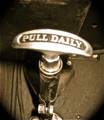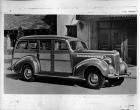|
Re: Oil pressure sender questions
|
||||
|---|---|---|---|---|
|
Forum Ambassador
|
Not sure which terminal you refer to when you say spade but it sounds like something was replaced incorrectly before you got the car.
What we call spade in my industry is two prongs with a space of whatever stud size between so one doesn't have to remove the nut or screw as you would a ring but it fits exactly same. If the spade you refer to is flat, and approx 1/4 in wide with a small slot that is pushed on a tab, then that is a more modern type we call a blade and never used by Packard to my knowledge. They did use a push on that we call bullet type today which is round and approx 1/8 diameter but it would still fit on a stud (brake lite switch as example). If you had a push on blade type before, then I think someone put an aftermarket sender on and maybe not the correct one for your car and might be why you're replacing it.
Posted on: 2008/7/5 13:53
|
|||
|
||||
|
Re: Mal's '41 120 Coupe
|
||||
|---|---|---|---|---|
|
Home away from home

|
Quote:
Kevin, Thanks! -Tom
Posted on: 2008/7/5 13:48
|
|||
|
||||
|
Re: Help. Pinion shaft torque spects
|
||||
|---|---|---|---|---|
|
Home away from home

|
Thanks for all the response. I have a few more questions for you guys. Does the yoke bottom out on a shoulder cut on the pinion shaft? In other words when you torque the nut to the 200 to 300 foot pounds are you applying that pressure to the bearing or are you just tightening the the nut against a shoulder stop on the pinion shaft behind the yoke. With out some kind of shoulder it would be like tightening a wheel bearing nut to 300 pounds. Way too much. The book says wheel bearings are supposed to be torqued to 20 foot pounds and then backed off one flat of the nut. Sense I'm not replacing any of the internal parts the idea of a spacer installed in front of the yoke makes good sense to me. It would allow for the crush sleeve to crush a little more hence resetting the bearing preload.
A side line story to this is I once replaced the pinion seal on my 1955 Olds 88 and was not sure how tight the nut should be so I set it like you would set a wheel bearing nut. Needless to say the nut was not tight enough and backed off because of normal vibration. I was on a trip and noticed some slop in the drive train but kept on plugging a head . I got to where I was going and pulled off the freeway. I got a couple of blocks and the nut fell off. The whole drive shaft pulled out of the differential and dropped down and fell out of the car. Couldn't believe seeing my drive shaft on the street from my rear view mirror. That's mainly why I am paranoid about doing this again. I'm really lucky this happened at 10 to 15 MPH on a surface street and not on the freeway at 75. Bob
Posted on: 2008/7/5 12:48
|
|||
|
||||
|
Re: brake lights
|
||||
|---|---|---|---|---|
|
Home away from home
|
The following two Wells hydraulic brake light switches will work on the 55th/56th series cars:
Wells BF 4805 - two prong for non torsion-level Wells RB 403 - three prong for cars with torsion-level The electrical connectors on the RB 403,(that fits early '70s VWs) three prong switch are different but, internally and operationally it is the same switch as the original and can be used by changing the wiring connectors. The two-prong switch, listed above, is a direct replacement for the one on the 55th & 56th series, non torsion-level suspension cars. I do not know but would suspect that it can be used on earlier models.
Posted on: 2008/7/5 12:31
|
|||
|
||||
|
Re: Oil pressure sender questions
|
||||
|---|---|---|---|---|
|
Webmaster
|
That could have been a running part change. So in 1953 if you needed a new sender for your '52, Packard may have just given you the new style one. Happens all the time. Perhaps they found the spade style one was subject to coming loose, and changed to ring style. Or they just changed suppliers.
Posted on: 2008/7/5 11:31
|
|||
|
-BigKev
1954 Packard Clipper Deluxe Touring Sedan -> Registry | Project Blog 1937 Packard 115-C Convertible Coupe -> Registry | Project Blog |
||||
|
||||
|
Re: New wiring harness?
|
||||
|---|---|---|---|---|
|
Webmaster
|
Since you are NOT looking for a resto harness, and you are converting to 12v, I would recommend just using an aftermarket GM style harness and fusebox combo. You can get an entire harness for less than $200 from places like EZ-Wire, Painless, etc. Also the GM style harnesses have almost the exact same wire colors as our Packard harnesses do. So under the hood where the wiring is visible, most of the colors will be exactly the same as the Packard wiring scheme.
I bought a 22 circuit harness because I am adding power windows, locks, AC, etc to my Packard, but keep as much of it hiden from view as possible. I bought Packard windows switches, but I will use a modern window motor setup instead of the hydraulic window setup they used in '54. But you can find smaller circuit harnesses that will do just fine. If you go to a modern harness, then you will have to swtich to 12v, as the wire size and rating in a modern harness is not sufficient to handle the higher amp load of a 6v system.
Posted on: 2008/7/5 11:25
|
|||
|
-BigKev
1954 Packard Clipper Deluxe Touring Sedan -> Registry | Project Blog 1937 Packard 115-C Convertible Coupe -> Registry | Project Blog |
||||
|
||||
|
Re: Getting at instrument wiring???
|
||||
|---|---|---|---|---|
|
Forum Ambassador
|
Glad you succeeded. Better luck than others have had getting it far enough forward. Speedo cable probably needs pulling entirely out, cleaned and relubed with the graphite based stuff made for that purpose. Make sure it isn't limp or kinked anywhere. Don't remember if that speedo does, but some have a small oil hole above shaft that could stand a drop of light oil to wet the felt.
As to clock, the points probably need cleaning & burnishing and mechanism probably also just needs cleaning & lube. Lube with instrument or watchmakers oil-nothing heavier. Others say they've had luck with WD_40 and just as many say no way. I vote with the latter because it seems to work for a short while but collects dust and becomes gummy on things I've used it on.
Posted on: 2008/7/5 11:17
|
|||
|
||||
|
Re: Help. Pinion shaft torque spects
|
||||
|---|---|---|---|---|
|
Home away from home
|
Obviously, the procedure document did not upload with this reply. If anyone is interested in the procedure, please contact me and I will send it to you.
Posted on: 2008/7/5 11:16
|
|||
|
We move toward
And make happen What occupies our mind... (W. Scherer) |
||||
|
||||
|
Re: Help. Pinion shaft torque spects
|
||||
|---|---|---|---|---|
|
Home away from home
|
I do not know if the Packard differentials are the same as early Cadillac ones, but I had an experience replacing the pinion oil seal in my 1939 Cadillac Sixty Special. It was not a straight-forward job. The complication was that once the spacer had been collapsed by tightening the pinion nut to set the pinion bearing preload, it would no longer provide the proper preload when retightened. To overcome this, a fellow Cadillac owner suggested using shims to restore the length of the spacer so that when it was retorqued, it would again be the proper length, and provide the proper preload. The tightening involved two parts; first, tighten the pinion nut with a considerable torque reading (200-300 lbs). To assure that it was not too tight or too loose check the overall torque to turn the pinion nut, with the brakes completely backed-off, to indicate a small torque reading in a few INCH pounds. Failure to provide the proper bearing preload would result in premature bearing failure. Included with this is a procedure that I helped him write describing the procedure to follow.
Posted on: 2008/7/5 11:14
|
|||
|
We move toward
And make happen What occupies our mind... (W. Scherer) |
||||
|
||||








